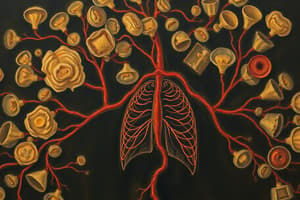Podcast
Questions and Answers
What is the primary function of capillaries in the circulatory system?
What is the primary function of capillaries in the circulatory system?
- Regulating blood pressure throughout the body
- Facilitating the exchange of materials between blood and tissues (correct)
- Storing excess nutrients until needed
- Transporting oxygenated blood to the heart
How does oxygen move from the blood into cells?
How does oxygen move from the blood into cells?
- Endocytosis within the cell membrane
- Chemical reaction facilitated by enzymes
- Diffusion down the concentration gradient (correct)
- Active transport against the concentration gradient
Which system is responsible for draining excess tissue fluid?
Which system is responsible for draining excess tissue fluid?
- Nervous system
- Lymphatic system (correct)
- Digestive system
- Endocrine system
What distinguishes double circulation in mammals from single circulation in bony fish?
What distinguishes double circulation in mammals from single circulation in bony fish?
What adaptation of cardiac muscle cells aids in the function of the heart?
What adaptation of cardiac muscle cells aids in the function of the heart?
Which of the following is a key reason for lymph passing through lymph nodes?
Which of the following is a key reason for lymph passing through lymph nodes?
What is the main role of the heart's two halves in mammals?
What is the main role of the heart's two halves in mammals?
What process is used for the exchange of substances between tissue fluid and cells?
What process is used for the exchange of substances between tissue fluid and cells?
What is the primary function of atrioventricular and semilunar valves in the heart?
What is the primary function of atrioventricular and semilunar valves in the heart?
What adaptation allows arteries to manage the high pressure of blood pumped from the heart?
What adaptation allows arteries to manage the high pressure of blood pumped from the heart?
Which statement accurately describes the differences between arteries and veins?
Which statement accurately describes the differences between arteries and veins?
What causes occlusion of the coronary arteries?
What causes occlusion of the coronary arteries?
How does fetal hemoglobin differ from adult hemoglobin in terms of oxygen affinity?
How does fetal hemoglobin differ from adult hemoglobin in terms of oxygen affinity?
What is a vital function of gas exchange in organisms?
What is a vital function of gas exchange in organisms?
What structural feature of veins helps to ensure blood flows towards the heart?
What structural feature of veins helps to ensure blood flows towards the heart?
Why is the measurement of pulse rates typically done at specific locations like the neck or forearm?
Why is the measurement of pulse rates typically done at specific locations like the neck or forearm?
Study Notes
Heart & Circulatory System
- Cardiac muscle cells have adaptations that allow them to efficiently pump blood, including high endurance and rhythmic contractions.
- Capillaries possess thin walls and small diameters, facilitating efficient material exchange between blood and tissues.
- Capillary branching increases surface area, enhancing the exchange of nutrients, gases, and waste.
- Diffusion, driven by concentration gradients, allows oxygen and nutrients to enter cells while waste products like carbon dioxide exit.
- The lymphatic system drains excess tissue fluid, termed lymph, and returns it to the circulatory system; lymph nodes filter the lymph to remove foreign particles.
- Bony fish have a single circulation system where blood passes through the heart once, while mammals have a double circulation system to separate oxygenated and deoxygenated blood, supporting higher metabolic rates.
- The mammalian heart has strong, thick-walled muscles to generate force and is divided into left and right halves to maintain blood separation.
- Atrioventricular and semilunar valves in the heart prevent backflow, ensuring unidirectional blood flow.
- Coronary arteries supply oxygenated blood to the heart tissue, critical for its function.
Structure and Function of Blood Vessels
- Arteries consist of three layers: tunica intima, media, and adventitia; they have wider lumens and thicker walls to withstand high-pressure blood flow.
- Veins also contain three layers but have narrower lumens and one-way valves to prevent backflow of blood; they are thinner and less elastic than arteries.
- Arterial adaptations include thick, elastic walls to manage pressure changes and maintain constant blood flow.
- Measuring pulse rates can be done by placing fingers on the neck or forearm at arterial sites.
Coronary Artery Health
- Coronary arteries supply the heart muscle with blood; blockage due to plaque buildup can impair blood flow and damage heart tissue.
Gas Exchange
- Gas exchange is essential for all organisms to intake oxygen and eliminate carbon dioxide.
- Fetal hemoglobin differs from adult hemoglobin, with a higher affinity for oxygen due to its composition (two alpha and two gamma chains) compared to adult hemoglobin (two alpha and two beta chains).
- Adult hemoglobin has four heme groups for oxygen binding and facilitates carbon dioxide binding at an allosteric site, exhibiting lower overall affinity for oxygen.
- The Bohr effect explains how increased carbon dioxide in blood reduces hemoglobin's oxygen affinity, promoting oxygen release to tissues.
Studying That Suits You
Use AI to generate personalized quizzes and flashcards to suit your learning preferences.
Description
Test your knowledge on the circulatory system, including the roles of hemoglobin, gas exchange, and ventilation. This quiz covers adaptations of cardiac muscle cells and capillaries to optimize blood and material exchange. Challenge yourself to apply what you've learned about how the heart and circulatory system function.





